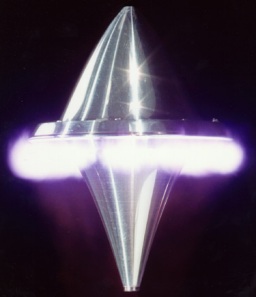Some of the next few posts here are going to be continuing the discussion of human outmigration, now focusing on possible destinations beyond our solar system.
Before delving too much into the nearby stars and considerations of reaching them, I want to briefly touch on some alternative technologies to pulsed atomic fission which could conceivably get us there.
Regarding space travel propelled by fusion reactors, antimatter, Bussard ramjets, Alcubierre warp-drives and the like; I find them interesting to think about but irrelevant to this current discussion. Technology which may or may not exit one day is intriguing, but I'm much more interested in things that we have the technology to build right now. Because that "one day" may never come, or may only come many millenia in the future.
This is not pessimism, and it is not trivial. Human technology has always progressed in rapid bursts followed by very, very long plateaus, and we may have already reached our newest plateau. The last 50 years have seen huge advances in computer technology and biotechnology and medicine, but most other technologies have remained relatively stagnant. Rocket-powered space flight, atomic fission nuclear reactors, jet aircraft, submarines, digital computers and radio-propagated television all existed in some form or another by the end of World War II. Gasoline-powered internal combustion is still the most efficient motive force we have harnessed to date.
We have no reason, at all, to anticipate that we will advance beyond these technologies within another thousand years, or ever.
So, my focus is on technologies which do currently exist. The rest is science fiction.
I am currently only aware of one technology which exists even in prototype which has an equal or better chance of getting humans to the nearest stars than pulsed fission. That is Leik Myrabo's Lightcraft. Lightcraft utilizes a very powerful pulsed laser or maser (the original prototype used a laser from the Reagan-era "Star Wars" program) aimed at the vehicle to either superheat the atmosphere around it or ablate part of the vessel itself to generate (a lot of) thrust. By not carrying chemical or nuclear fuel, you end up with a spacecraft which is mostly payload.
You may have seen a video for this which was circulating about a year ago on YouTube. It isn't readily apparent, but the video was actually shot around 1999; it just needed a forum like YouTube to reach a larger audience. Here's the video:
http://www.youtube.com/watch?v=6wMpU7AZGvQ
There are some pretty serious issues with Lightcraft from the standpoint of crewed spaceflight. For example, I don't know how most passengers would handle being centrifuged at 6000 rpm, which is apparently necessary for stability. It is not inconceivable that the passenger compartment could be isolated from this rotation, and buffered from the 20 Gs of lift the craft generates on lift-off. But it's a consideration.
Meanwhile, Lightcraft technology is being seriously considered for small payload Low Earth Orbit transport. For a total cost of about $50,000 (including the satellite) Lightcraft can place a 100 kg satellite into orbit. Compared to $50 million + for an Atlas/Delta launch, that's a pretty huge savings.
For interstellar applications Lightcraft is actually a tiny bit faster than pulse fission, but it requires much more time for deceleration so the overall time enroute is slightly more for a 4 lightyear trip that it would be for Orion, but these differences are functionally pretty negligible.
So, as this series continues I'm going to continue to focus on pulse fission, because that technology is far more ready to be applied off-the-shelf to this purpose. But history may one day prove that Lightcraft technology is how we actually accomplish our first missions to the nearest stars.

No comments:
Post a Comment